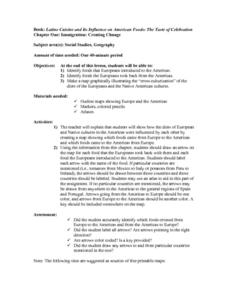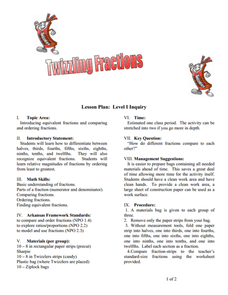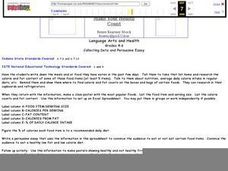Curated OER
Making Choices to Save Money on Food
Students review lists of coupons and complete a worksheet to analyze the benefits of the specials. In this household budget activity, students determine which foods are nutritional and the advantages of using coupons or specials to save...
Curated OER
Food Detectives
Students investigate the regions in which particular grains are grown. Using the packaging from a variety of foods, grains are identified and the general locations where they are grown are plotted on a map.
Curated OER
At the Supermarket
In this supermarket worksheet, students complete a crossword puzzle, label the food items, complete the conversation, and more. Students complete 5 activities total.
Curated OER
All Things Chinese-- Building a Classroom Museum
Students explore China. For this introduction to Chinese culture lesson, students bring in items or pictures from home that represent Chinese culture. Students create a "Chinese museum" by putting these labeled items on display,...
Curated OER
Food vis Ships
Learners take a short quiz before embarking on their journey. They explore all different types of food around the world as well as labeling all those places on a world map. Observance is given to all the different types of vehicles used...
Curated OER
Favorite Food Graph (Blank)
In this math learning exercise, students create a bar graph to display the results of "your Favorite Food Survey." The graph is not labeled but has spaces for all the choices.
Federal Reserve Bank
Government Spending and Taxes
What types of government programs are designed to improve economic inequity in the United States? Introduce your learners to government programs, such as low-income housing, Social Security, and Medicaid, how they work to improve...
Curated OER
Health and Fitness Expo
A health and fitness expo hosted by the 4th and 5th grade PE classes for the entire school. This is a great idea! There are 10 activities that are listed for the classes to participate in. For each of the activities, there is an...
Howard Hughes Medical Institute
Molecular Structure of Fat
Bad fat, good fat, trans fat, food fat—are all fats created equal? Get to the bottom of the types of fat with a well-crafted presentation. The resource covers adipose tissue, lipids, trans fats, and many other substances that fall under...
Reed Novel Studies
The Search for Delicious: Novel Study
Have you ever gone looking for one thing but ended up discovering something else? That is exactly what happened to Gaylen, a character in The Search for Delicious. Gaylen begins looking for a food to label as delicious, but...
Curated OER
Immigration: Creating Change
Students explore how immigration has changed the culture of America. After identifying the foods and diets of Europeans and Native cultures, students create a map indicating where foods came from. Students design a restaurant menu,...
Curated OER
Nutrition: How Much Fat Am I Eating?
How much fat is in this? Scholars first read some background information on the caloric content of fats versus carbohydrates, and then use that knowledge to analyze foods they regularly eat. They will look at 5 package labels for the...
Curated OER
Digestion and Nutrition
Debunk the theory that a soda-and-candy diet is a nutritionally sound concept! Learners first read 2 paragraphs of background information covering essential nutrients, digestion, and homeostasis. Then, they use the information they...
Curated OER
Can You Count on Cans?
How can a canned food drive be connected to math? It's as simple as counting and organizing the cans! Children demonstrate their ability to sort non-perishable foods into categories that include soup cans, vegetable cans, boxed items,...
Alabama Learning Exchange
CELEBRATE!
Strengthen research skills by reviewing the months of the year and the holidays celebrated during those months. Learners draw and label a timeline for the months and label each holiday. They work in groups to research the holidays, and...
Curated OER
Nutrition Lesson Plan
Third graders explore a variety of breakfast foods and beverages and write a creative story about their favorite. They then present their stories to the class and are encouraged to try different foods during the story time.
Curated OER
What Lives in Water?
In this early childhood science worksheet set, students study the importance of water, and determine the difference between themselves and water dwellers. They look at adaptations, river life, rainforest life, food chains, pollution, and...
Curated OER
Packaging Tricks
Learners become aware of the ways in which packaging is designed to attract kids. In a series of activites, students compare similar food products, assess nutritional value, and participate in field trip to see how packaging affects...
University of Arkansas
Twizzling Fractions
Using food as a manipulative is one of the best ways to incorporate hands-on learning in the classroom. This hands-on approach allows young mathematicians to compare, order, and identify fractions with the use of Twizzlers® and...
Curated OER
Bacteria
Learners study the advantages and disadvantages of bacteria. In this bacteria lesson students draw and label the different types of bacteria.
Curated OER
Plants
One slide reviews the main plant parts and most of the remaining slides address seven plant processes of life. This is a different approach to introducing the life of a plant. Three tasks are assigned to viewers on the last slide, making...
Curated OER
Survey Says...
Young learners create and implement a school-wide survey about student body favorites! Learners record and analyze the data on a bar graph, picture graph, and line graph, and then display the data. Then, wrap it all up with a celebration...
Curated OER
Kitchen Vocabulary Words
Working in groups of four, class members sort cards, labeled with kitchen equipment vocabulary words, into groups based on function, i.e., mixing tools, measurement tools, serving tools, baking pans, stove top pans, or preparation tools....
Curated OER
Make Your Health Count
Learners write down the meals they have eaten in the past few days and then research the calorie and fat content of at least 5 of the food items. They create a poster with the information they found and then put that information into a...






















